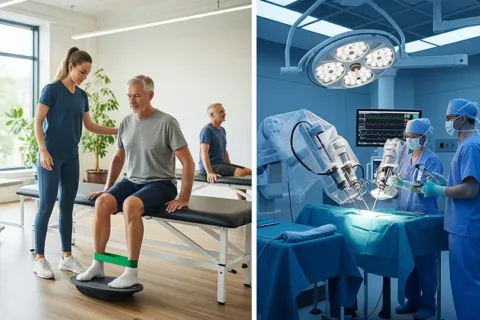Table of Contents
If you’re among the millions of people worldwide struggling with chronic back pain, you’ve likely found yourself standing in the pharmacy aisle, wondering whether to reach for another bottle of painkillers, or considering whether physiotherapy vs painkillers might offer a better long-term solution for your persistent discomfort. This decision isn’t just about immediate relief—it’s about choosing a path that could determine your quality of life for years to come.
As Dr. Iqra Kiran, a leading female physiotherapist with over 5 years of experience and founder of Physio Rehab Solution in Rawalpindi Cantt, I’ve witnessed countless patients grapple with this very dilemma. Through my practice at Mayo Hospital Lahore and now at my own clinic, I’ve seen firsthand how both approaches can impact lives—sometimes dramatically differently.
Chronic back pain affects approximately 80% of adults at some point in their lives, making it one of the leading causes of disability worldwide. The choice between physiotherapy and pain medication isn’t simply black and white; it’s a nuanced decision that depends on various factors including the underlying cause of your pain, your lifestyle, medical history, and long-term health goals.
Understanding Chronic Back Pain: The Foundation of Treatment Decisions
Before diving into the physiotherapy vs painkillers debate, it’s crucial to understand what chronic back pain actually means. Unlike acute pain that typically resolves within a few days or weeks, chronic back pain persists for three months or longer. This persistent pain can stem from various causes including herniated discs, muscle strain, spinal stenosis, arthritis, or even stress-related tension.

The complexity of chronic back pain lies in its multifaceted nature. It’s not just about the physical sensation—chronic pain affects your sleep patterns, mood, work productivity, and relationships. This is where the treatment approach becomes critical, as the method you choose will impact not just your pain levels but your overall quality of life.
At Physio Rehab Solution, I’ve observed that patients who understand their condition tend to make more informed decisions about their treatment path. Whether you’re dealing with lower back pain from poor posture, sciatica from a compressed nerve, or upper back tension from stress, the underlying mechanism of your pain plays a significant role in determining the most effective treatment approach.
Painkillers for Chronic Back Pain: The Quick Fix Approach
Painkillers, medically known as analgesics, work by interrupting pain signals between the injury site and your brain. For chronic back pain, doctors typically prescribe several categories of medications:

Over-the-Counter Options:
- NSAIDs (Non-Steroidal Anti-Inflammatory Drugs) like ibuprofen and naproxen
- Acetaminophen for pain relief without anti-inflammatory effects
- Topical analgesics for localized relief
Prescription Medications:
- Muscle relaxants for spasm-related pain
- Stronger NSAIDs for severe inflammation
- Opioids for severe, treatment-resistant pain
- Antidepressants that also affect pain perception
- Anticonvulsants for nerve-related pain
Benefits of Painkillers:

Immediate Relief: The most significant advantage of pain medication is rapid symptom relief. Within 30-60 minutes of taking an oral painkiller, many patients experience noticeable pain reduction, allowing them to function better in their daily activities.
Accessibility: Pain medications are readily available, often without prescription, making them an immediate option when back pain flares up unexpectedly.
Standardized Dosing: Unlike physiotherapy, which requires individualized treatment plans, pain medications come with clear dosing guidelines that are easy to follow.
Emergency Management: For severe pain episodes, medications can provide crucial relief that allows patients to seek further medical attention or begin other treatments.
Drawbacks and Risks of Long-term Painkiller Use:

Dependency and Tolerance: Perhaps the most concerning aspect of long-term painkiller use is the development of physical dependence and tolerance. Your body gradually requires higher doses to achieve the same level of pain relief, potentially leading to addiction, particularly with opioid medications.
Side Effects: Chronic use of NSAIDs can cause stomach ulcers, kidney problems, and cardiovascular issues. Opioids can lead to constipation, drowsiness, and respiratory depression. Even acetaminophen can cause liver damage when used excessively.
Masking Underlying Issues: While painkillers address symptoms, they don’t treat the root cause of chronic back pain. This masking effect can sometimes lead to further injury as patients feel better and overexert themselves.
Cost Over Time: Regular pain medication use can become expensive, especially if you require prescription-strength drugs not fully covered by insurance.
Physiotherapy for Chronic Back Pain: The Comprehensive Healing Approach

Physiotherapy, also known as physical therapy, takes a fundamentally different approach to chronic back pain management. Rather than simply masking pain signals, physiotherapy addresses the underlying mechanical, muscular, and postural issues that contribute to ongoing discomfort.
At Physio Rehab Solution, our comprehensive approach includes various evidence-based techniques:
Manual Therapy: Hands-on techniques including spinal manipulation, joint mobilization, and soft tissue massage to improve mobility and reduce pain.
Exercise Therapy: Customized strengthening and flexibility programs designed to address specific muscle imbalances and movement patterns contributing to back pain.
Postural Training: Education and correction of everyday postures that may be perpetuating or worsening back pain.
Pain Education: Teaching patients about pain science helps them understand their condition and develop better coping strategies.
Modalities: Use of heat, cold, electrical stimulation, and other therapeutic modalities to enhance healing and pain relief.
Benefits of Physiotherapy:

Addresses Root Causes: Unlike medications that mask symptoms, physiotherapy identifies and treats the underlying mechanical problems causing your back pain. This might include muscle weakness, joint stiffness, poor posture, or movement dysfunction.
Long-term Results: While physiotherapy may take longer to show initial results compared to painkillers, the improvements tend to be longer-lasting. Patients often experience sustained relief months or even years after completing their physiotherapy program.
Improves Overall Function: Physiotherapy doesn’t just reduce pain—it improves your overall physical function, strength, flexibility, and endurance. Many patients report feeling stronger and more capable than before their injury.
No Side Effects: When performed by qualified professionals like those at Physio Rehab Solution, physiotherapy has virtually no negative side effects, making it safe for long-term use.
Cost-Effective: While the upfront cost of physiotherapy may seem higher, it’s often more cost-effective in the long run as it reduces the need for ongoing medications, repeated doctor visits, and potential surgical interventions.
Educational Component: Physiotherapy empowers patients with knowledge about their condition and self-management strategies, reducing the likelihood of future episodes.
Potential Drawbacks of Physiotherapy:

Time Investment: Physiotherapy requires a significant time commitment, typically involving 2-3 sessions per week for several weeks or months.
Initial Discomfort: Some patients experience temporary increases in pain or soreness as their body adapts to new movements and activities.
Requires Active Participation: Unlike taking a pill, physiotherapy requires active engagement and motivation from the patient to perform exercises and follow through with recommendations.
Delayed Results: While some patients notice improvements within a few sessions, others may need several weeks of consistent treatment before experiencing significant pain relief.
Physiotherapy vs Painkillers: A Direct Comparison

Effectiveness for Different Types of Back Pain
Mechanical Back Pain: For pain caused by poor posture, muscle imbalances, or joint dysfunction, physiotherapy typically provides superior long-term results. Research shows that patients with mechanical back pain who receive physiotherapy are significantly less likely to experience recurring episodes compared to those who rely solely on medication.
Inflammatory Conditions: Conditions like ankylosing spondylitis or rheumatoid arthritis that affect the spine may benefit from both approaches. Anti-inflammatory medications can help manage acute flares, while physiotherapy maintains mobility and function between episodes.
Nerve-Related Pain: Sciatica and other nerve-related back pain conditions often respond well to specific physiotherapy techniques that address nerve mobility and reduce compression. However, severe nerve pain may initially require medication for symptom management while physiotherapy addresses the underlying cause.
Acute vs. Chronic Presentations: For recent injuries (acute pain), a combination approach often works best—medications for initial pain control followed by physiotherapy for rehabilitation. For chronic conditions, physiotherapy typically provides better long-term outcomes.
Safety Profiles
The safety comparison between physiotherapy vs painkillers is quite stark. Physiotherapy, when performed by qualified professionals, has an excellent safety record with minimal risk of adverse effects. The most common “side effects” are temporary muscle soreness or minor increases in pain as the body adapts to new movements.
In contrast, long-term painkiller use carries significant risks including:
- Gastrointestinal problems (NSAIDs)
- Cardiovascular risks (certain NSAIDs)
- Liver damage (acetaminophen overdose)
- Kidney problems (NSAIDs)
- Addiction potential (opioids)
- Cognitive effects (various medications)
Cost Analysis
When comparing costs, it’s important to consider both short-term and long-term expenses:
Short-term Costs:
- Painkillers: $20-200+ per month depending on type and dosage
- Physiotherapy: $80-150 per session, typically 12-20 sessions initially
Long-term Costs:
- Painkillers: Ongoing monthly expenses, potential medical costs from side effects
- Physiotherapy: Minimal ongoing costs after initial treatment, occasional tune-up sessions
Many patients find that while physiotherapy has higher upfront costs, it’s more economical over time due to lasting results and reduced need for ongoing medical interventions.
When to Choose Physiotherapy vs. Painkillers
Choose Physiotherapy When:
- You have mechanical or postural back pain
- You want to address the root cause of your pain
- You’re concerned about medication side effects or dependency
- You have recurring episodes of back pain
- You want to improve your overall physical fitness and function
- You prefer a natural, non-pharmacological approach
- You have time to commit to a treatment program
Choose Painkillers When:
- You need immediate pain relief for daily functioning
- You have severe acute pain that prevents movement
- You have inflammatory conditions requiring medical management
- Physiotherapy isn’t immediately available
- You need short-term relief while waiting for other treatments
- You have contraindications to exercise or manual therapy
Consider a Combined Approach When:
- You have severe chronic pain affecting multiple aspects of life
- You’re transitioning from acute to chronic pain management
- You have complex conditions with both inflammatory and mechanical components
- Initial pain levels are too high to participate effectively in physiotherapy
The Role of Lifestyle Factors in Treatment Success
Regardless of whether you choose physiotherapy vs painkillers, certain lifestyle factors significantly impact treatment success:

Sleep Quality: Poor sleep can amplify pain signals and slow healing. Both treatment approaches work better when combined with good sleep hygiene.

Stress Management: Chronic stress can perpetuate back pain through muscle tension and inflammation. Stress reduction techniques enhance both medication and physiotherapy effectiveness.

Nutrition: A balanced diet supports healing and can help reduce inflammation naturally, complementing both treatment approaches.

Activity Levels: Maintaining appropriate activity levels is crucial. Complete bed rest can worsen back pain, while excessive activity can aggravate symptoms.

Work Ergonomics: Addressing workplace factors that contribute to back pain is essential for long-term success with any treatment approach.
Making the Right Choice for Your Situation
The decision between physiotherapy vs painkillers isn’t always an either/or choice. Many successful treatment plans incorporate elements of both approaches, strategically using each method’s strengths while minimizing potential drawbacks.
Immediate vs. Long-term Goals: If your primary concern is getting through the workday with manageable pain, medications might be your immediate solution. However, if you’re focused on long-term health and preventing future episodes, physiotherapy offers superior outcomes.
Personal Preferences: Consider your comfort level with different treatment approaches. Some people prefer the active, hands-on approach of physiotherapy, while others find the simplicity of medication more appealing.
Medical History: Your past experiences with medications, allergies, and other health conditions should factor into your decision. Always consult with healthcare providers about potential interactions or contraindications.
Support System: Physiotherapy often requires support from family members or employers for scheduling and activity modifications. Consider whether you have the necessary support system in place.
Evidence-Based Research: What the Studies Show
Recent research comparing physiotherapy vs painkillers for chronic back pain consistently shows that physiotherapy provides superior long-term outcomes. A landmark study published in the Journal of the American Medical Association found that patients receiving physiotherapy had significantly better pain and function scores at one year compared to those relying primarily on medication.
Another comprehensive review of multiple studies found that while medications provide faster initial relief, physiotherapy patients had:
- 40% greater reduction in pain scores at 6 months
- 60% better functional improvement at one year
- 50% lower likelihood of pain recurrence
- Significantly better quality of life measures
These findings align with what we observe at Physio Rehab Solution, where patients who complete comprehensive physiotherapy programs often report sustained improvements lasting years beyond their initial treatment.
Integration with Other Treatments
Modern pain management recognizes that the most effective approach often involves integration of multiple treatment modalities. At Physio Rehab Solution, we offer comprehensive care that may include:
Chiropractic Care: Spinal manipulation and adjustment techniques that complement physiotherapy exercises.
Acupuncture: Traditional Chinese medicine approach that can help reduce pain and improve function when combined with physiotherapy.
Pain Management Techniques: Including mindfulness, relaxation training, and cognitive behavioral strategies.
Lifestyle Counseling: Addressing diet, sleep, stress, and activity modifications that support recovery.
This integrated approach allows us to customize treatment plans that may strategically incorporate medications when necessary while building toward long-term solutions through physiotherapy and lifestyle modifications.
Conclusion: Making an Informed Decision
The debate between physiotherapy vs painkillers for chronic back pain relief doesn’t have a one-size-fits-all answer. However, the overwhelming evidence supports physiotherapy as the superior long-term solution for most chronic back pain conditions.
While painkillers certainly have their place in comprehensive pain management—particularly for acute flares or severe symptoms that prevent participation in active treatments—they should generally be viewed as a temporary bridge rather than a permanent solution.
Physiotherapy offers the unique advantage of addressing both symptoms and underlying causes, providing patients with lasting relief and improved function while avoiding the risks associated with long-term medication use. The investment in time and effort required for physiotherapy typically pays dividends in the form of sustained pain relief and improved quality of life.
At Physio Rehab Solution in Rawalpindi Cantt, we’ve seen countless patients successfully transition from medication dependency to pain-free, active lives through comprehensive physiotherapy programs. As the leading female physiotherapist in Rawalpindi, Dr. Iqra Kiran is committed to helping each patient find the most effective, safest, and most sustainable approach to managing their chronic back pain.
If you’re struggling with chronic back pain and wondering whether physiotherapy vs painkillers is the right choice for you, consider scheduling a consultation to discuss your specific situation. Remember, the best treatment plan is one that addresses your individual needs, goals, and circumstances while prioritizing your long-term health and well-being.
Your journey to pain-free living doesn’t have to be traveled alone. With the right combination of expert guidance, evidence-based treatment, and personal commitment, lasting relief from chronic back pain is not just possible—it’s achievable.
Ready to Choose the Right Path for Your Back Pain Relief?
Don’t let chronic back pain control your life any longer. If you’re tired of relying on temporary fixes and ready to invest in a long-term solution that addresses the root cause of your pain, it’s time to take action.
Why Choose Dr. Iqra Kiran at Physio Rehab Solution?
✅ Expert Care: Over 5 years of specialized experience in physiotherapy and pain management
✅ Comprehensive Services: Physiotherapy, Chiropractic Care, Acupuncture, and Pain Management under one roof
✅ Proven Results: Leading female physiotherapist in Rawalpindi with countless success stories
✅ Personalized Treatment: Customized rehabilitation programs tailored to your specific condition
✅ Modern Facility: State-of-the-art clinic in Rawalpindi Cantt with latest therapeutic equipment
Take the First Step Toward Pain-Free Living Today:
🔹 Book Your Initial Consultation – Get a comprehensive assessment of your back pain and discover which treatment approach is right for you
🔹 Visit Our Website – Learn more about our services and read success stories at www.physiorehabsolution.com
🔹 Call Now – Speak directly with our team to schedule your appointment
🔹 Free Pain Assessment – Take advantage of our comprehensive evaluation to understand your condition better
Don’t wait another day to start your journey toward lasting relief. Your pain-free future begins with a single decision to choose the right treatment approach.
FAQs (Frequently Asked Questions)
Is physiotherapy better than painkillers for chronic back pain relief?
Research consistently shows that physiotherapy provides superior long-term results for chronic back pain compared to painkillers alone. While painkillers offer immediate relief, physiotherapy addresses the root cause of pain, leading to lasting improvement and reduced risk of recurrence. At Physio Rehab Solution, Dr. Iqra Kiran combines evidence-based physiotherapy techniques to help patients achieve sustainable pain relief without the risks associated with long-term medication use.
How long does physiotherapy take to work for chronic back pain?
Most patients begin experiencing improvements within 2-4 weeks of starting physiotherapy, with significant pain reduction typically occurring within 6-8 weeks. However, complete recovery timeframes vary depending on the severity of your condition, compliance with exercises, and individual healing factors.
Can I combine physiotherapy and painkillers for back pain treatment?
Yes, combining physiotherapy and painkillers can be an effective approach, especially during the initial treatment phase. Pain medications can help manage severe symptoms while you begin physiotherapy exercises.
What are the side effects of long-term painkiller use for back pain?
Long-term painkiller use can cause serious side effects including stomach ulcers, kidney damage, liver problems, cardiovascular issues, and potential addiction (especially with opioids). NSAIDs can also interfere with bone healing and increase bleeding risk. This is why physiotherapy is often recommended as a safer alternative for chronic back pain management at Physio Rehab Solution.
Is physiotherapy expensive compared to painkillers for back pain?
While physiotherapy has higher upfront costs, it’s typically more cost-effective long-term. Painkillers require ongoing monthly purchases that can cost $50-300+ monthly for years, while physiotherapy provides lasting results after initial treatment.
Which type of back pain responds best to physiotherapy vs painkillers?
Mechanical back pain from poor posture, muscle imbalances, or joint dysfunction responds exceptionally well to physiotherapy. Nerve-related pain (sciatica) and chronic conditions also benefit significantly from physiotherapy techniques. Inflammatory conditions may initially require anti-inflammatory medications alongside physiotherapy.
Where can I find the best physiotherapy for back pain in Rawalpindi?
Physio Rehab Solution in Rawalpindi Cantt, led by Dr. Iqra Kiran, is recognized as the premier physiotherapy clinic in the area. With over 5 years of specialized experience and comprehensive services including physiotherapy, chiropractic care, and pain management, Dr. Iqra Kiran is considered the best female physiotherapist in Rawalpindi for back pain treatment.
How many physiotherapy sessions do I need for chronic back pain?
Most chronic back pain patients require 12-20 physiotherapy sessions for optimal results, typically spread over 6-12 weeks. Complex cases may need additional sessions, while simpler conditions might resolve sooner. Dr. Iqra Kiran provides personalized treatment plans at Physio Rehab Solution, adjusting session frequency based on your progress and specific needs.
Can physiotherapy help if painkillers haven't worked for my back pain?
Absolutely! Many patients who haven’t found lasting relief with painkillers experience significant improvement with physiotherapy. Since painkillers only mask symptoms while physiotherapy addresses underlying causes, it’s common for patients to succeed with physiotherapy even after unsuccessful medication trials.
What should I expect during my first physiotherapy appointment for back pain?
Your first appointment with Dr. Iqra Kiran includes a comprehensive assessment of your pain history, physical examination, movement analysis, and discussion of your goals. She’ll explain your condition, develop a personalized treatment plan, and may begin gentle treatments during the initial visit. At Physio Rehab Solution, we ensure you understand your condition and treatment approach from day one.









